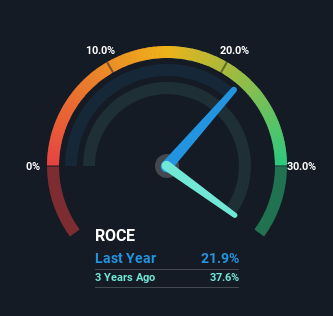- South Korea
- /
- Consumer Durables
- /
- KOSE:A021240
Some Investors May Be Worried About COWAY's (KRX:021240) Returns On Capital

If we want to find a potential multi-bagger, often there are underlying trends that can provide clues. Ideally, a business will show two trends; firstly a growing return on capital employed (ROCE) and secondly, an increasing amount of capital employed. Basically this means that a company has profitable initiatives that it can continue to reinvest in, which is a trait of a compounding machine. Having said that, while the ROCE is currently high for COWAY (KRX:021240), we aren't jumping out of our chairs because returns are decreasing.
What Is Return On Capital Employed (ROCE)?
If you haven't worked with ROCE before, it measures the 'return' (pre-tax profit) a company generates from capital employed in its business. Analysts use this formula to calculate it for COWAY:
Return on Capital Employed = Earnings Before Interest and Tax (EBIT) ÷ (Total Assets - Current Liabilities)
0.22 = ₩731b ÷ (₩4.9t - ₩1.5t) (Based on the trailing twelve months to December 2023).
So, COWAY has an ROCE of 22%. In absolute terms that's a great return and it's even better than the Consumer Durables industry average of 6.3%.
View our latest analysis for COWAY

Above you can see how the current ROCE for COWAY compares to its prior returns on capital, but there's only so much you can tell from the past. If you'd like to see what analysts are forecasting going forward, you should check out our free analyst report for COWAY .
How Are Returns Trending?
When we looked at the ROCE trend at COWAY, we didn't gain much confidence. While it's comforting that the ROCE is high, five years ago it was 45%. Meanwhile, the business is utilizing more capital but this hasn't moved the needle much in terms of sales in the past 12 months, so this could reflect longer term investments. It's worth keeping an eye on the company's earnings from here on to see if these investments do end up contributing to the bottom line.
On a side note, COWAY has done well to pay down its current liabilities to 31% of total assets. That could partly explain why the ROCE has dropped. Effectively this means their suppliers or short-term creditors are funding less of the business, which reduces some elements of risk. Since the business is basically funding more of its operations with it's own money, you could argue this has made the business less efficient at generating ROCE.
Our Take On COWAY's ROCE
To conclude, we've found that COWAY is reinvesting in the business, but returns have been falling. And investors appear hesitant that the trends will pick up because the stock has fallen 35% in the last five years. Therefore based on the analysis done in this article, we don't think COWAY has the makings of a multi-bagger.
If you want to continue researching COWAY, you might be interested to know about the 1 warning sign that our analysis has discovered.
If you'd like to see other companies earning high returns, check out our free list of companies earning high returns with solid balance sheets here.
If you're looking to trade COWAY, open an account with the lowest-cost platform trusted by professionals, Interactive Brokers.
With clients in over 200 countries and territories, and access to 160 markets, IBKR lets you trade stocks, options, futures, forex, bonds and funds from a single integrated account.
Enjoy no hidden fees, no account minimums, and FX conversion rates as low as 0.03%, far better than what most brokers offer.
Sponsored ContentNew: AI Stock Screener & Alerts
Our new AI Stock Screener scans the market every day to uncover opportunities.
• Dividend Powerhouses (3%+ Yield)
• Undervalued Small Caps with Insider Buying
• High growth Tech and AI Companies
Or build your own from over 50 metrics.
Have feedback on this article? Concerned about the content? Get in touch with us directly. Alternatively, email editorial-team (at) simplywallst.com.
This article by Simply Wall St is general in nature. We provide commentary based on historical data and analyst forecasts only using an unbiased methodology and our articles are not intended to be financial advice. It does not constitute a recommendation to buy or sell any stock, and does not take account of your objectives, or your financial situation. We aim to bring you long-term focused analysis driven by fundamental data. Note that our analysis may not factor in the latest price-sensitive company announcements or qualitative material. Simply Wall St has no position in any stocks mentioned.
About KOSE:A021240
COWAY
Engages in the production and sale of environmental home appliances in South Korea and internationally.
Solid track record with excellent balance sheet.
Similar Companies
Market Insights
Community Narratives



